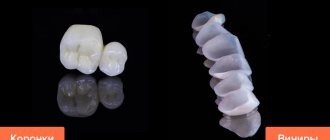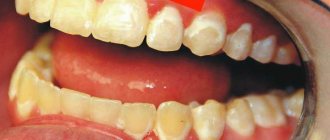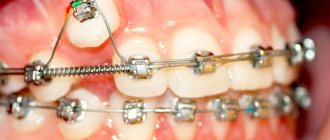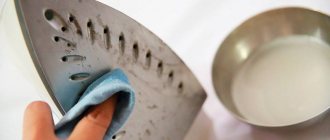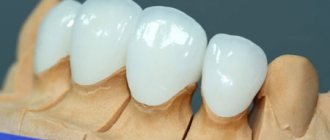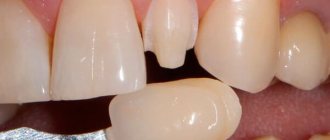It turns out that crooked or incorrectly positioned teeth in adults can be corrected not only with the help of braces or clear aligners. Orthopedic structures such as veneers can also correct such problems. However, such treatment has a number of important limitations. Therefore, aesthetic correction of the shape and size of, as a rule, crooked front teeth is not indicated for all patients. So, when is it possible to correct crooked teeth with veneers and is it possible to make teeth straight only thanks to aesthetic restorations, without resorting to wearing braces? Leading orthopedist Sergei Sergeevich Zarivny from the ILATAN family clinic in Moscow talks about this.
What are veneers
Classic veneers are thin plastics or onlays (thickness 0.2-0.8 mm), which are non-removable microprostheses. They are placed only on the visible side of the dentition, i.e. on one side of the tooth, slightly catching the cutting edges. And only on the front teeth - incisors, canines, and less often - on premolars, but they are not installed on chewing teeth. Plates improve the aesthetics of a smile, make it brighter, change the shape of dental crowns - which is an advantage in the presence of curvature (but there are some nuances here).
A separate individual onlay is fixed to each tooth, made according to impressions of the jaws of a particular patient. For this orthopedic design, only ceramics1 or materials based on it are used (there is no metal), so patients practically do not develop allergies. For veneers, you need to contact an orthopedic dentist, who is popularly called a “prosthetist” - he is the one who installs any microprostheses and prostheses.
How teeth are restored with composite veneers
Installation of dental microprostheses made of composite lasts no longer than 60 minutes. At the beginning of the appointment, the specialist examines the patient, assesses the condition of the dentition and eliminates visible defects, having previously discussed this with the patient.
While working, the dentist:
- It grinds down the tooth a little, which makes it possible to preserve the natural dimensions of the dentition. The level of thickness of the grinding layer depends on the type of composite product and the type of defect. As a rule, 0.3-0.6 mm is removed.
- A restrictive cord is temporarily inserted between the teeth and gums, protecting the gum area from injury and allowing the contours of a dental microprosthesis to be correctly formed. Once the installation of the veneers is complete, the restrictive cord is removed.
- The surface of the teeth is treated with a special agent that helps prevent the development of caries. The surface is dried.
- The first layer of composite is applied to the clean surface area. The layer is leveled, the excess part is removed. The composite is fixed using ultraviolet light. The action is repeated 2-3 times.
- The manufactured veneers are leveled, their shape is brought to an ideal state, the shape should be close to natural.
- The final stage is grinding the surface of the composite lining. Despite the care taken when performing, re-grinding is required after a few months. To maintain an aesthetic appearance, you will need to carry out similar procedures every 5 months.
Will veneers correct curvature?
Is it possible to put veneers on crooked teeth? Yes, you can. This is a very fast and effective way to correct curvature. Moreover, you can additionally make your smile much more attractive in appearance by choosing the desired shade and shape for the overlays. By the way, specialized “smart” programs help the doctor with this - for example, Digital Smile Design (DSD).
But are veneers always installed on crooked teeth? Here, a lot depends on the condition of the patient’s bite. If, when closing the dentition with a distal, mesial or deep bite, some teeth put a lot of pressure on each other or on soft tissues, then veneering will only do harm - injuries will appear, and the plastics themselves may come off. But, for example, when the pathology of the bite is not very developed or the teeth are slightly curved, there are gaps between them (diastemas, trema), then the linings will allow you to mask such defects for a very long time.
That is, inside the jawbone, the tooth roots will not “correctly” turn or move, but on the outside the smile will look very attractive, due to the fact that the problem areas are covered with overlays. You also need to remember that correcting curvature with microprostheses is only possible in the front zone of the smile. If there are problems in the chewing sector, then this method will not help.
Contraindications
Not every patient has the opportunity to install dental microprostheses.
It is unacceptable to install onlays on the frontal area of the teeth for people suffering from:
- malocclusion (straight, deep, cross);
- bruxism (the habit of grinding your teeth);
- periodontal disease, periodontitis or worsened gingivitis;
- advanced caries;
- tooth destruction by 50% or more;
- not fully erupted tooth;
- periodontal disease, periodontitis or gingivitis in the acute stage
- absence of more than 7 chewing teeth;
- habit of chewing hard objects with teeth.
People who practice martial arts and boxing need to give up the idea of veneering. The pads are not able to withstand powerful impacts and will constantly deteriorate.
Veneers are the best method to help cope with crooked teeth. By choosing the right specialist, you can quickly install the onlays and enjoy the acquisition of a dazzling smile.
Types of veneers to correct curvature
Currently, all known types of dental onlays can be divided in several directions - by wearing time, by material, by manufacturing method. Let's look at them in a little more detail.
By wearing time
All veneers are permanent, there are simply no removable ones! This needs to be understood by those people who, having seen an advertisement for “removable” pads at an attractive price, rush to order them for themselves. Nothing good will come of this, since such products will constantly fall out of your mouth (after all, they are made according to the same template for everyone). And provoke various injuries to the tissues of the oral cavity.
Read on the topic: all about removable veneers - what they are and why they can harm your teeth.
Real microprostheses are worn for 5-10-20 years - the wearing period depends on the material and method of their manufacture. Moreover, the enamel underneath does not deteriorate and caries does not appear (of course, with proper installation). After all, the plates are fixed with a special adhesive composition - it is, on both sides, “embedded” in the structure of natural enamel and the artificial material of the microprosthesis.
By material
Teeth onlays can be made from the following materials:
- composite composition: in fact, this is an analogue of a filling mass, which can additionally be strengthened with nanoparticles (such products are called “componers”)
- porcelain or simple ceramics: the most well-known and long-used material, but its strength (about 80-100 MPa) is lower than that of more modern ceramic compositions,
- leucite glass ceramic IPS Empress: a highly aesthetic material with a flexural strength of 160 MPa allows the creation of natural-looking restorations with a long wearing life,
- ceramics based on lithium disilicate IPS E.max: plates made from it are called “ultraneers” because they are very thin - this is due to the increased strength of 470 MPa,
- ceramic composite: the combination of ceramic and composite is one of the most modern materials that have begun to be used in recent years. It also produces very thin overlays, under which your own enamel does not always have to be ground,
- zirconium dioxide and aluminum dioxide: the most durable materials (650-1400MPa). But they have one drawback - an unnaturally white color and poor transparency. Therefore, despite the small thickness of the product initially, it has to be covered with a layer of ceramics on top,
- Lumineers: the thinnest of all microprostheses (about 0.2 mm), so you don’t have to grind down your own enamel. You can’t put on one record – only a set of 6-8 pieces. They are made from nanohybrid “secret” material. Moreover, they are produced only in 1 laboratory in the USA.
Zirconium dioxide crown on an implant for the whole 70,000 rubles.
OSSTEM implant (South Korea), individual zirconium abutment, gum former, impression taking.
Creation of a Prettau zirconium crown using 3D modeling technology. Consultation with 2 doctors: an orthopedist and an implantologist for free! Call now or request a call
Opening hours: 24 hours a day - seven days a week
By manufacturing method
How are veneers made for crooked teeth? Classic overlays are made only by the indirect method, i.e. in a dental laboratory, using impressions of the dentition. But the indirect method also has its own subtypes - this is layer-by-layer application and sintering of liquid ceramic masses, pressing, milling on computerized machines. For such products you only need to contact an orthopedist, and the prosthetic process itself takes from 1-2 weeks to 1-1.5 months.
Another method is called “direct” and it occurs by applying layer-by-layer material directly in the patient’s mouth. Essentially, this is an artistic restoration with a filling or therapeutic veneers. The time spent here is much less - literally 1-2 hours. Both an orthopedist and a dental therapist can make such a restoration.
Kinds
Manufacturers produce 2 types of veneers:
- made on the basis of ceramics;
- made from composite.
The best dental prostheses are considered to be ceramic types, which can last more than 12 years. Composite types need to be changed every 3-4 years. Various materials :
- porcelain;
- glass ceramics;
- zirconium dioxide.
Reference! Depending on the type of ceramic, the appearance of the product and the level of strength may vary.
Depending on what material was used in the manufacturing process, the cost of dental microprostheses is determined. A variety of technologies can be used in the production of dental onlays.
The manufacturer can produce devices :
- pressing method;
- applying in layers;
- using milling on machines that are programmed for a certain course of work.
The characteristics of the technical and aesthetic type of dental microprostheses depend on what method the manufacturer used in the process of their manufacture.
Composite products are made on the basis of filling materials. Such devices can be installed at the first visit to the dentist. The composite product is inexpensive, but not particularly durable. The duration of operation does not exceed 3-4 years. Dentists do not recommend using composite veneers for people who consume tea, coffee, carrots and other staining foods. If they have already been installed, you should regularly visit a doctor for resurfacing.
Ceramic is the most popular and durable type of veneers. Once the appliance is installed, it is impossible to distinguish them from real teeth. There is no discomfort while wearing. You can leave the veneers on for 12-15 years. Even after so many years, the material does not darken or discolor.
Veneers made on the basis of ceramics contribute to:
- increasing the strength of teeth;
- natural and aesthetically pleasing smile, the shade of the ceramic product does not change, there is no exposure to food coloring;
- long service life (more than 15 years) subject to wearing rules.
When giving preference to ceramic microprosthetics, it is worth considering that it will be impossible to install a veneer on 1 tooth. You will need to install about 6-8 ceramic overlays over the entire frontal area. In order to improve the appearance of one crooked tooth, it is enough to insert a cheaper composite analogue. The low cost will make it easy to replace the veneer if damaged with a new one.
Why a dentist may refuse installation - contraindications
An orthopedist may refuse to install microprostheses for the following reasons:
- the presence of large fillings and chips in the enamel (more than 50% of the crown volume),
- weak enamel,
- the presence of formations under the tooth roots (cysts, granulomas),
- pronounced curvature or incorrect position of those teeth in the row that are subject to restoration,
- bruxism or hypertonicity of the masticatory muscles.
There are also relative contraindications that can be eliminated first and then veneers can be placed on crooked teeth. For example, this is inflammation of the gums (gingivitis), caries, pulpitis. But in the case of pulpitis, the service life of the tooth will noticeably decrease, so it is better to put a crown on it.
Photos before and after
By looking at the before and after photos below, you can be convinced of the effectiveness of veneering. The smile after the procedure becomes dazzling. The presence of chipped and crooked teeth no longer bothers the patient.
Advantages and disadvantages of alignment with microprostheses
One of the pros and cons of correcting crooked teeth with classic veneers is how they are placed. This is relatively quick (you don’t have to wear corrective devices for years - braces or aligners) and is very aesthetically pleasing and durable. But, at the same time, you have to grind down your own tooth enamel - and it cannot be restored if you want to remove the ceramic onlays. You just have to install new or artificial crowns.
The advantage of restoration with veneers using the direct manufacturing method is an even higher speed of correction of crooked teeth, and the price is low. But the disadvantages include fragility and rapid loss of aesthetics, and a shorter service life.
Pros and cons of straightening teeth with veneers and crowns
The advantages of such treatment are obvious. There is no need to wear braces and other orthodontic structures on the teeth for a long time. In most cases, you can get straight teeth in a month or less. If the teeth had an unattractive shape and color, then these defects will also be corrected by installing veneers or crowns. But, unfortunately, such treatment also has disadvantages, and quite significant ones. Even to install veneers on your teeth, you will have to grind them down, and the more pronounced the anomaly, the more dental tissue will have to be removed. Especially when crowns are required. In addition, straightening teeth with orthotics can be quite expensive. Thus, the installation of one ceramic veneer starts from 25,000 rubles in “economy” level dentistry.
Basic installation steps
How are veneers placed on crooked teeth? To correct curvature you need to go through several successive stages. Let's look at them in more detail:
- diagnostics: undergoing an x-ray examination, assessing the condition of the enamel, identifying diseases. Photo-diagnostics for modeling ideally suited microprostheses,
- treatment of caries stomatitis (if necessary),
- removal of tartar and plaque,
- turning enamel and taking impressions,
- installation of temporary overlays,
- production of microprostheses in the laboratory (takes 1 week or more),
- installation of products for the patient.
If the patient chooses restoration in 1 visit, i.e. using the direct method, this is possible immediately after removing the stone and plaque. However, if there were a lot of deposits and the gums are bleeding, then you will have to wait for them to heal for several days, and only then carry out restoration.
How does dental restoration work with ceramic veneers?
Restoration of the dentition with ceramic dental microprostheses is carried out in stages.
Below is information that will help you become more familiar with each stage .
| Preparation | Before you begin installing veneers, you will need to go through a preparation phase. During this period, the dentist must examine the patient, decide on the need for the procedure, and give recommendations. It is possible to carry out therapy for diseased teeth and various pathological processes in the oral cavity. At the end of the appointment, the patient can choose the shade of the design. |
| Grinding | Before installing dental microprostheses, it is necessary to clean your teeth. To do this, the dentist begins to remove the layer of enamel and the hard part of the teeth (about 0.5-0.6 mm). The doctor determines the removal thickness based on the thickness of the plates being installed. A smaller layer of the hard part of the teeth is removed when installing a composite product. Cleaning on this day is not complete, since during the production of veneers, plastic plates are installed on the dentition for a couple of weeks. |
| Taking impressions and modeling | Impressions are made from a special solution, which the doctor will apply to the tooth and wait for it to completely harden. Already 5 minutes after application the solution sets. The form is removed and taken to the laboratory. |
| Manufacturing | Using the impression taken, the specialist makes plaster impressions with composite onlays. Each of the dental microprostheses is checked for compliance with the outline and color scheme. In case of deviations from the shape or feeling of severe discomfort while wearing, the veneers are removed and adjusted again to the ideal result. It is important that the pads do not interfere with the patient’s full life. To achieve the most accurate result, the laboratory uses microscopes, with the help of which the dentist can achieve the maximum level of tightness of the edge fit of the product to the tooth. This is what guarantees the production of microprostheses that will last a long time. |
| Installation | The dentist treats the oral cavity and plates with an antiseptic, which makes it possible to avoid the entry of microorganisms. The inside of the veneer remains rough, and the teeth are treated with a special gel composition to give good roughness, which will allow the veneer to adhere faster. Cement paste is used for bonding, which quickly hardens when exposed to direct light. And at the last stage, all remaining cement is removed and the bite is checked. |
Video about installing plates:
What is better to choose
To understand what is better to choose, veneers or braces/aligners, let's refer to the table below. In it we compare the main characteristics of microprostheses and orthodontic devices.
| Evaluation parameter | Veneers | Braces |
| Installation area | Only on the front teeth, less often on the “fours” (first premolars). Can be placed on just 1 tooth | Placed only on the entire dentition at once |
| Degree of curvature | Only a small one | Any, even very strong. Sometimes placed in combination with corrective surgery |
| Changing the shade and shape of dental crowns | Yes | No |
| The need for professional hygiene and remineralization | Yes | Yes |
| Turning the enamel layer | Almost always necessary (rare exceptions are possible - when using ceramic composite or lumineers) | Turning is unnecessary and even dangerous |
| Features of care | Easy care | Care is very thorough - after each meal you need to clean with special brushes |
| Wearing period | From 7-10 years and longer | From 6 months to 2-3 years |
| Habituation and wearing comfort | There is almost no need to get used to it, the comfort is very high | The addiction is often painful and lasts 1-2 weeks. Comfort average |
| Which dentist should I contact? | To an orthopedist or dental therapist for initial diagnosis | To the orthodontist |
| Frequency of doctor visits after installation | Once every 6-12 months | Every 3-4 weeks during the entire wearing period |
| Price | From 7 thousand rubles for 1 tooth | From 30 thousand rubles for installation on 1 jaw |
To compare how your smile transforms, pay attention to the photo below. One picture shows the effect on crooked teeth before and with veneers.
On the other, a smile before and after wearing braces. By the way, after correction with braces, it is quite possible to install ceramic onlays. But not vice versa, i.e. Braces cannot be placed on veneers.
“And for a long time I didn’t think about how best to make my crooked teeth straight and beautiful)) I had a choice - either wear veneers or get braces. And since I work with people, braces were out of the question. They installed very beautiful ceramic plastics, many now notice that their smile has changed.”
Irina, review from gidpozubam.ru
Comparison with other dental methods
There are many ways to successfully resolve dental problems. Each of them is worth describing briefly to have an idea and compare with the mini veneers we are talking about today.
Crowns. Not the best method for correcting crooked teeth. When installing them, neighboring formations inevitably suffer, which leads to damage to tooth enamel. This technique has become widespread due to its comparative cheapness. It is mainly used to straighten the bite and is placed on the incisors. For canine teeth, dental construction is less effective. The materials from which they are made are metal ceramics and ceramics.
Trainers. They are mainly used in pediatric dentistry. The optimal age for installation is up to 14 years. Silicone devices copy the shape of the jaw well and require mandatory fixation in the upper and lower parts of the oral cavity. With the help of such products, intensive training of the facial muscles is carried out and correct breathing through the nose is formed.
When asking the question: “is it possible to correct an overbite and crooked teeth with veneers or trainer structures,” it is important to remember that the latter are relevant only for minor deficiencies. There is no need to wear them all the time.
Mouthguards. These are special plastic plates that follow the shape of the sky. Indicated for correction of curvature, used for correction in children from 8 years of age. The plates cannot be removed during therapy.
When worn, they do not cause any inconvenience, and due to their transparency they are invisible. They attract patients with low prices. However, in difficult cases (serious curvature of the row, malocclusion) they are ineffective.
Braces. These devices have long proven themselves to be the best. They are attached directly to the tooth surface and create the necessary tension and pressure, due to which alignment occurs. They can only be installed at the top or bottom. Withdrawal during the treatment period is not allowed.
Surgical intervention. Involves grinding down the enamel layer. In some cases, it is possible to remove the bone structure. This technique is used only in the most difficult situations, when all other methods fail.
Which method should you prefer?
According to the recommendations of dentists, the solution to serious problems should be entrusted to braces. They are most effective in eliminating pronounced defects in children during the period of jaw formation.
If you are wondering: “Is it possible to get veneers if your teeth are uneven?” you need to take into account the opinion of doctors. They recommend installing onlays when it is necessary to correct minor curvatures and as a means of masking visual imperfections. If the dental plates are significantly curved or there is a violation of the jaw relationship, then veneers will not be effective.
It is important to understand that all correctional methods are most effective at a young age. Therefore, you should not delay visiting the dentist. The sooner a specialist identifies the pathology, the faster it will be possible to get rid of it. In choosing the appropriate technique, doctors rely on:
- patient's age;
- his general condition;
- the presence of specific problems in the oral cavity.
Service life and care
When thinking about whether it is possible to correct crooked teeth with veneers, you need to remember that this “correction” is not permanent (like braces). Although even after braces you will have to wear retainers for a long time - special devices that restrain “spreading”. After some time, fillings or microprostheses will have to be replaced. And also take proper care of them to maximize their service life.
DENTAL PROSTHESIS ON 6 IMPLANTS - 290,000 rub.
The price includes all manipulations for installing Osstem implants (South Korea), manufacturing, installing and fitting the prosthesis, including anesthesia and diagnostics.
Save RUB 30,000. >> Call now or request a call
Opening hours: 24 hours a day - seven days a week
Thus, therapeutic restorations last an average of 5-7 years. But since their surface quickly loses its “smoothness” and begins to fade and absorb dyes, you will have to give up brightly colored products and regularly visit the dentist (at least 2 times a year) to remove the accumulated plaque and carry out polishing.
For classic ceramic, ceramic-composite and zirconium dioxide onlays, the service life starts at 10 years. But they can easily last more than 15 years if professionally manufactured and installed. Therefore, first of all, you need to approach the choice of an orthopedic dentist wisely. Restorations, despite their strength, should be treated with care - exclude hard foods (or cut them into pieces first), do not chew chewing gum, taffy, chew candy, and do not bite off pieces of hard foods with your front teeth. It is advisable to come to the clinic for a medical examination once a year.
How long does it take to replace veneers?
The service life of veneers depends on many factors:
- Material. Ceramic ones are more durable;
- The patient’s lifestyle, how carefully he “handles” dental veneers;
- Doctor's professionalism. If mistakes were made during installation, for example, the materials were not dried correctly, the veneers will not last long.
There is no clear period after which the linings must be replaced. This should only be done if there is an objective need. For example, if the veneer:
- Broken off;
- Peeled off;
- Darkened (relevant for composite overlays).
Cost of smile makeover
Prices for therapeutic veneers start from 5-7 thousand rubles for the restoration of 1 crooked tooth. As for classic overlays, their cost starts from 15-18 thousand rubles - also for 1 unit. Lumineers cost from 60-70 thousand rubles, and you need to install 6-8 pieces at a time - therefore the cost of a complete transformation is higher than all other microprostheses.
1Gurel G. Ceramic veneers. Art and Science, 2007.
Your questions and answers
QUESTION: I have a small gap between my front teeth on top, and my fangs are tilted slightly towards my lips. Can I get veneers to fix this, or are braces my only option? Elena
ANSWER Hello, Elena. Many patients correct crooked teeth (if they are small) with veneers. It's fast - faster than correction with braces or aligners. And absolutely everyone is happy with the effect. Therefore, if you want to know the exact answer to your question, visit the dentists in person. It is better to go to both an orthodontist and an orthopedist, take a panoramic photo and tomography of the jaw. Then it will be clear whether you can get veneers or still reserve time and carry out correction with braces.
Author: Chernov A. R. (Thank you for your help in writing the article and the information provided)
